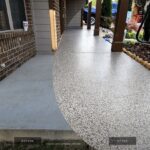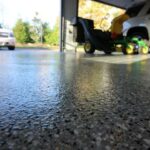Epoxy Flooring 101: Everything You Need to Know
Epoxy flooring is a hot topic these days, and it’s not hard to see why. This durable, vibrant, and cost-effective flooring material is gaining popularity among homeowners and commercial business owners alike. If you’ve been thinking about upgrading your flooring, you might be wondering what all the fuss is about. Well, fear not! We’ve got everything you need to know about epoxy flooring right here. From the benefits and features to the installation process and maintenance, we’ll cover it all in this comprehensive guide. So, sit back, relax, and let’s dive into the world of epoxy flooring!
Overview of Epoxy Flooring and its Benefits
Epoxy flooring is gaining popularity in residential and commercial settings due to its durability, easy maintenance, and visually appealing finish. Made of multiple layers of epoxy resins, this surface covering solution offers a range of benefits that make it an ideal choice for various applications.
One of the significant advantages of epoxy flooring is its resistance to chemical spills, making it perfect for industrial settings. This durable flooring option can withstand oils, chemicals, and abrasion, while maintaining its fresh and polished appearance.
Not only is epoxy flooring visually pleasing, but it is also highly resistant to scratches, scuffs, and dents, making it a practical choice for homes with pets or young children. Its ability to withstand wear and tear ensures long-lasting beauty and functionality.

Epoxy Flooring 101
Customizability is another key benefit of epoxy flooring. With a wide range of colors, textures, and patterns available, homeowners and businesses can tailor their epoxy floors to their specific needs and preferences. This versatility allows for creative expression and flexibility in design.
In addition to its aesthetic and functional advantages, epoxy flooring can be applied to various existing surfaces, including concrete, tiles, and wood. This makes it a versatile option for those who want to renovate their homes or workplaces without undergoing extensive construction.
Epoxy flooring stands out as a surface covering solution that combines durability, ease of maintenance, and aesthetic appeal. With its resistance to chemicals, ability to withstand wear and tear, and customizability, it offers a range of benefits for both residential and commercial applications. Whether you’re looking to enhance the appearance of your home or create a durable and attractive flooring solution for your business, epoxy flooring is an excellent choice.
Types of Epoxy Flooring & Their Uses
When it comes to epoxy flooring, there are various types available on the market. Each type offers unique features and benefits that cater to different needs and preferences. Here are some of the most popular types of epoxy flooring and their common uses:
1) Self-Leveling Epoxy Flooring – This type of epoxy is ideal for areas with heavy foot traffic such as warehouses, commercial kitchens, and showrooms. It has a smooth finish and is easy to clean, making it perfect for high-traffic areas.
2) Mortar Epoxy Flooring – This type of epoxy contains quartz sand or other aggregates that provide added strength and durability. It is commonly used in industrial settings due to its resistance to heavy machinery and chemical spills.
3) Flake Epoxy Flooring – As the name suggests, this type of epoxy contains flakes that give it a unique textured appearance. It is commonly used in garages, basements, and other residential spaces due to its slip-resistant properties.
4) Metallic Epoxy Flooring – This type of epoxy features metallic pigments that create a stunning three-dimensional effect. It is often used in retail stores, restaurants, and other commercial spaces for its eye-catching appearance.
No matter what type of space you need to cover, there is an epoxy flooring solution that can meet your needs. With a range of options available, you can choose the one that best fits your budget, aesthetic preferences, and functional requirements.
Installation Process of Epoxy Flooring
Now that you know about the benefits and types of epoxy flooring, you might be wondering about the installation process. While it is recommended to hire a professional for the job, here is a general overview of how epoxy flooring is installed:
- Preparation – The first step in installing epoxy flooring is to prepare the surface by removing any debris, oil stains, or old coatings. This will ensure proper adhesion and a smooth finish.
- Priming – Once the surface is clean and dry, a primer is applied to create a bond between the concrete and epoxy layers.
- Mixing and Applying Epoxy Resin – The next step is to mix the epoxy resin (consisting of a resin and hardener) according to manufacturer instructions. This mixture is then poured onto the prepared surface and spread evenly with a squeegee.
- Adding Decorative Elements (Optional) – If you are using a flake or metallic epoxy, this is the stage where decorative elements are added to create the desired texture and appearance.
- Curing – After applying the epoxy, it needs time to cure. The curing process typically takes 24-72 hours, depending on the type of epoxy used.
- Finishing Touches – Once the epoxy is fully cured, a clear topcoat is applied to seal and protect the surface. This topcoat also adds shine and enhances the appearance of the flooring.
Installing epoxy flooring is a meticulous yet rewarding endeavor. With proper installation and maintenance, you can enjoy a stunning and long-lasting flooring solution for years to come.
Maintenance Tips for Optimal Longevity of Your Epoxy Floor
Epoxy floors are long-lasting, durable, and visually-appealing flooring options that can easily withstand heavy foot traffic and the wear and tear of everyday life. However, to ensure your epoxy floor remains functional and looks great for years to come, regular maintenance is key. Here are some essential tips to help you achieve optimal longevity of your epoxy floor.
Firstly, routine cleaning is important to maintain the shine and gloss of your epoxy floor. Regular sweeping and mopping will remove any dirt or debris that may accumulate on the surface, preventing any scratches or discolorations. Additionally, always clean any spills as soon as they occur to prevent any staining. Avoid using heavy detergents or harsh chemicals when cleaning your epoxy floors, as this can lead to dulling and damage.

Epoxy Flooring 101
Secondly, protect your epoxy floors from any heavy impact by using floor mats and similar protective gear. This is especially important in high-traffic areas such as entryways, hallways, and kitchens. Avoid dragging heavy objects, such as furniture, over the floor, which can leave scratches and marks. When moving heavy items, use furniture sliders to minimize the risk of damage.
Finally, it is essential to schedule regular professional maintenance for your epoxy floor. Professional floor care experts have the knowledge and experience to handle any maintenance challenge that may arise, from minor scratches to deep cleaning to repairs and beyond. By investing in professional care for your epoxy floor, you can rest assured that it will remain beautiful, functional, and durable for many years to come.
Cost-Effective Alternatives to Installing Epoxy Floors
While epoxy flooring offers numerous benefits and is a popular choice for many commercial and residential spaces, it may not be the most cost-effective option for everyone. Here are some cost-effective alternatives to installing epoxy floors:
- Polished Concrete – If you have an existing concrete floor in good condition, polishing it can be a cost-effective option. It creates a glossy and durable surface that is easy to maintain.
- Vinyl Flooring – Vinyl flooring comes in various designs and styles, including ones that mimic the look of epoxy flooring. It is an affordable and low-maintenance option for those looking for a similar aesthetic.
- Carpet Tiles – For spaces that require added warmth and comfort, carpet tiles can be a budget-friendly alternative. They are easy to install and replace, making them ideal for high-traffic areas.
- Laminate Flooring – Another option that can mimic the look of epoxy flooring is laminate. It is affordable, durable, and easy to maintain.
No matter what type of flooring you choose, it is important to consider your budget, functional needs, and aesthetic preferences before making a decision. With the right flooring choice and proper maintenance, you can create a beautiful and functional space that will last for years to come. So go ahead, explore your options and find the perfect flooring solution for your space!
Epoxy flooring is an excellent choice for both residential and commercial spaces due to its durability, versatility and aesthetic appeal. From the installation process to maintenance tips and cost-effective alternatives, we hope this guide has provided valuable insights into epoxy flooring that will help you make an informed decision for your space. Remember, no matter what type of flooring you choose, regular maintenance and professional care are essential to ensure its longevity and functionality. Invest wisely in your flooring choice, and enjoy a beautiful, durable and long-lasting surface for many years to come. So why wait? Consider epoxy flooring for your next project and experience the benefits first-hand!
Concrete Coatings All Year
https://www.google.com/maps?cid=15073981344419381280
2400 Satellite Blvd Suite K, Buford, GA 30518, United States
+1 678-580-6370
https://concretecoatingsallyear.com/






Leave a Reply